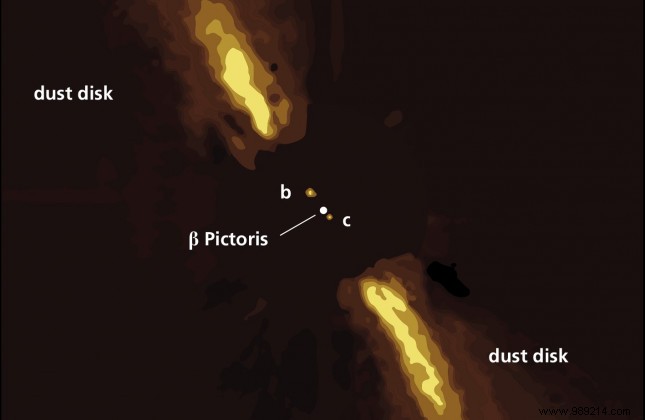A team of astronomers has relied on ESO's Very Large Telescope to image a nearby exoplanet some 20 million years old. Details of the study are published in Astronomy &Astrophysics .
While today there are more than 4,200 worlds in more than 2,800 planetary systems, remember that all these planets were located by indirect means (transit or radial velocity method, mainly). And on this sample, only a few could be imaged directly. At such distances, and given the luminosity of their host star, the task is indeed very complicated. Each new photo is therefore a small event.
Recently, astronomers were able to obtain an image of an exoplanet located only 63 light years away of the earth. Its name:Beta Pictoris c (β Pic c), a gas giant orbiting around – you guessed it – Beta Pictoris. The planet is 8.2 times more massive than Jupiter, and orbits its star in 3.4 years, at a distance of 2.7 astronomical units (2.7 times the Earth – Sun distance).
This star is still very young, about 23 million years old . At this point, it is still surrounded by its disc of proto-planetary debris. In this still-nascent system, astronomers have spotted two worlds formed less than 19 million years ago. Beta Pictoris c, discovered last year, is the second of these planets. The first – Beta Pictoris b – was discovered in 2008.
As explained above, very few exoplanets can be directly imaged with our current technology. And for good reason:they must be big enough and close enough to the Earth, but at the same time far enough away from their star not to be dazzled by their light . Hence the interest of this planetary system, which meets all the criteria here.
Two years ago, this first exoplanet thirteen times more massive than Jupiter, which orbits around its star at a distance of about nine astronomical units, could thus be imaged directly . As part of the ExoGRAVITY collaboration, a project based on the GRAVITY instrument of the Very Large Telescope Interferometer , astronomers thought that β Pic c would therefore make an excellent candidate for direct imaging. The system is shown below:

The next step for astronomers will be to capture detailed spectra of the light emitted by the exoplanet. From there, they can determine its atmospheric composition. This same technique, tested on other more promising worlds, will be essential to search for signs of life elsewhere in the galaxy.